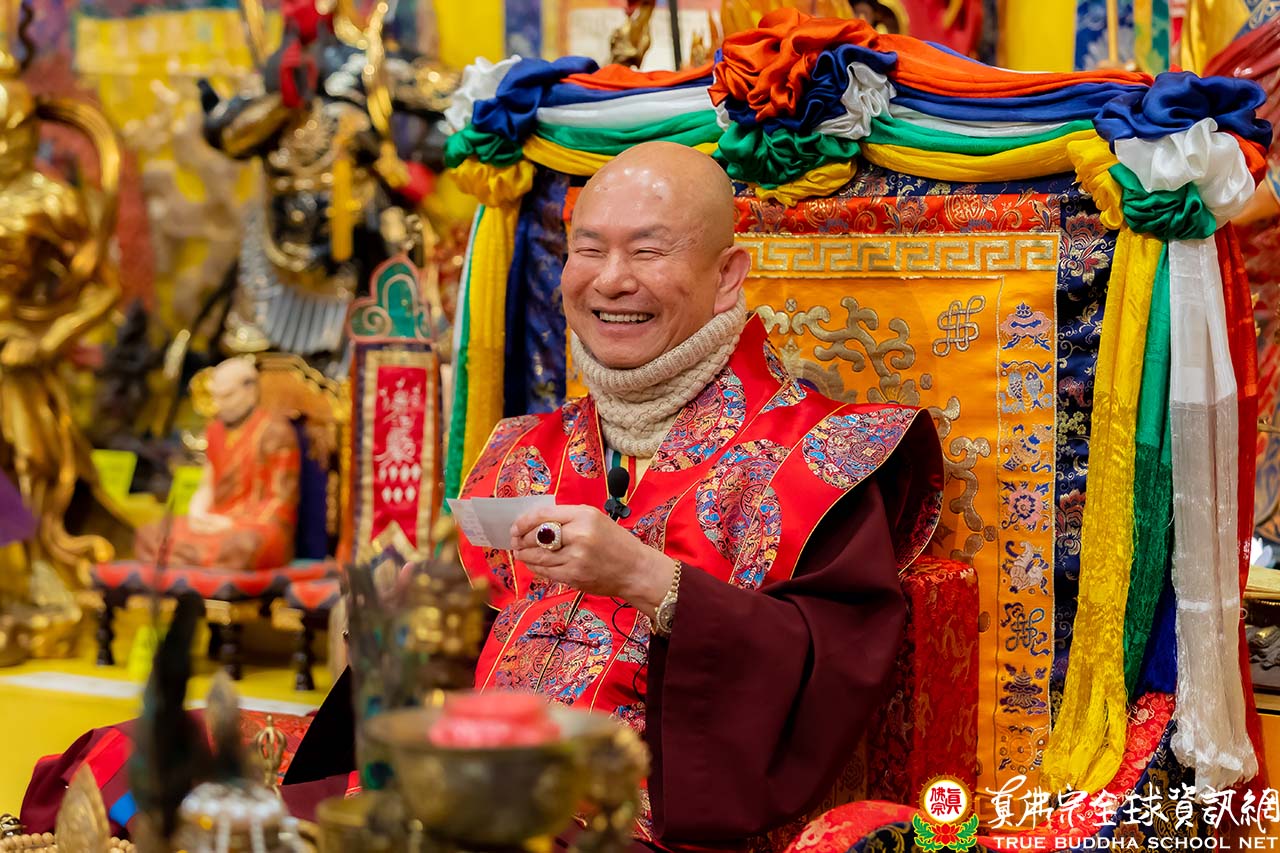
A Detailed Exposition of the Vimalakirti Sutra
by Grandmaster Lu, Living Buddha Lian Sheng of the True Buddha School
Translated into English by the True Buddha School Vimalakirti Translation Team
Prologue, 7 May 2022
Upon completion of the exposition on the Vajra Sutra, everybody kept pressuring me, “What are you going to expound next? Please tell us, please!” There were several suggestions: A Taiwanese disciple recommended Grandmaster to talk about Shurangama Sutra, a dialogue between Sakyamuni Buddha and Ananda. It is a very long sutra that requires a few years to discourse. Perhaps I might die before I finish talking about it.
Then Master Lian Wang said, “Grandmaster, please expound the Vimalakirti Sutra.” At the same time, I considered the Five Major Treatises, which Guru Tsongkapa stipulated that all Tantric Buddhist disciples should study. What are the Five Major Treatises? They include The Ornament for Clear Realization (Abhisamayalamkara), The Treasure of Knowledge (Abhidharmakosa), Introduction to the Middle Way (Madyamakavatara), Compendium of Valid Cognition (Pramanavartika), and The Precepts (Vinaya Sila Mulasastra). I thought about whether I should expound on one of them.
As I pondered about all these, an elder showed up in the sky. I looked closer and saw that it was a man with the four virtues—Vimalakirti. He told me, “Grandmaster Lu, why don’t you expound on the Vimalakirti Sutra?”
Vimalakirti—a great bodhisattva—is the central figure in this sutra. During Sakyamuni Buddha’s time, he reincarnated in India as a lay Buddhist and helped Sakyamuni Buddha deliver sentient beings. He originated from the Eastern Buddhaverse of Wonderful Joy (Abhirati, the buddhaverse of Aksobhya Buddha).
The story goes like this: As a stay-home practitioner, Vimalakirti had a wife—the famous Goddess who Scatters Flowers. One time, Vimalakirti was sick, so Sakyamuni Buddha asked his [close] disciples to visit. He first asked the arhats like Sariputra, Moggallana, Mahakasyapa, etc., to visit and show their care to Vimalakirti. But they all avoided seeing Vimalakirti. Sakyamuni Buddha then asked Maitreya Bodhisattva and the Fragrant Rigorous Youth, but they didn’t want to go either.
Finally, the Buddha asked Manjusri Bodhisattva—he was the only one who did not have any reservations about going. This sutra is about Manjusri’s visit and his dialogue with Vimalakirti. Only Manjusri Bodhisattva can see eye to eye with the great bodhisattva Vimalakirti.
This is a truly marvelous sutra, and the fact that Vimalakirti appeared and asked me to expound on the Vimalakirti Sutra is a good sign. This sutra is called The Vimalakirti Sutra, Vimalakirti Sutra as Spoken by the Buddha, or the Sutra of Inconceivable Liberation. [Also, as the Vimalakirti Nirdesa Sutra.] This sutra also includes extensive philosophy, ideology, and literature. As Buddhists, we should study the Vimalakirti Sutra.
In my understanding, there are two key points in this sutra: Firstly, “Only when the mind is pure, one’s realm or universe is pure.” The second key point is on the dharma gate of nonduality.
The mind is the key. When the mind is pure, any place becomes a spiritual center—pureland or buddhaverse.[1] Once one’s mind is purified, everything becomes pure. When the mind is pure, one’s universe is pure.
The second key point is on nondualism. It has been mentioned in this sutra that most arhats think that the world is dirty, that physical bodies are filthy and should be abandoned as soon as possible. Vimalakirti deems that such minds have diverted from nondualism because they still contain discrimination. Are you still discriminating between what is dirty and what is clean? What does it mean to be dirty? Or clean? If you still think that certain things are clean and others are dirty, or if you still categorize someone as good or bad, you still have discrimination in your mind [and you are not nondual].
In this sutra, Vimalakirti tells us to be nondual—free from dualistic views or differentiation. Nondualism teaches us not to view this world as impure. Once our mind is pure, the human world is a pureland. Before the mind is purified, you don’t realize that the human world is a pureland; you think it is impure, akin to how the arhats think.
According to legend and common belief, the lay person Vimalakirti was a great bodhisattva, and an emanation of a Buddha—Jinli Tathagata. This sutra became sensational in India and was also very popular in the Middle Kingdom, now known as China. The Vimalakirti Sutra—belonging to the Mahayana tradition—is well known in the Buddhist world. It talks about nondualism, attributing great importance to the mind, “When the mind is pure, one’s universe is pure.”
It is a marvelous sutra. It also includes many other points in addition to those two key points. It covers extensive transcendental or transformational power. There are a total of fourteen chapters. The first chapter—as usual—contains the causes and conditions of the dharma teaching; the reasons why Sakyamuni Buddha spoke on this sutra. Each chapter, from two to twelve, contains a certain dharma teaching. The last two chapters, thirteen and fourteen, primarily talk about the merit of the sutra. Although there are only fourteen chapters, each chapter is quite long and extensive. It will take me some time to complete this exposition. Once I'm ready, I will start expounding on this sutra, and may the exposition go well. That’s all for today.
Om mani padme hum.
[1] A buddhaverse, as in a buddha’s universe, is a novel term coined by Dr. Robert Thurman for a buddhaland, buddha-field, buddha-realm, or buddha-world, a translation from the Sanskrit “buddhakserta.”
Next discourse on the Vimalakirti Sutra: Introduction, 8 May 2022
Index of links to all discourse on the Vimalakirti Sutra: https://en.tbsn.org/guidem/detail/2975/
Back to the main index page of all dharma discourse: https://en.tbsn.org/guidem/index
Full webcast of 2022.05.07 Amitabha Group Practice (Ling Shen Ching Tze Temple, Redmond, USA) and dharma discourse with English interpretation: https://youtu.be/y3Wg6pl4lPI




